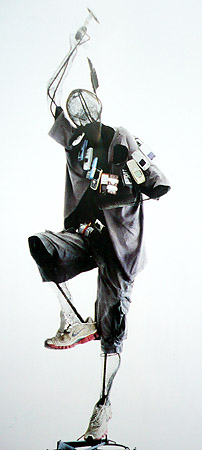2010-05-03
Science of Imagination (in Ludwig Musem) (part 1 / 4)
SCI-FI promenade at the other end of time ...
Ludwig Museum's new exhibition "Science of Imagination" is not only based on a theme but it's actually this theme that is being shown, this thought and all that it means including the whole era of Science-Fiction and so it as much as becomes an expression, a non-verbal 3-D multi-media essay, a complex installation ...
a cikk fejezetei:
::::: present calling the past, past calling the present
Ludwig Museum is so synonymous with contemporary art that this makes it an almost a weird act that this time they function as a traditional museum, showing something from the past that visitors can walk around and study, which is the Sci-Fi. But there's a twist, of course. The exhibits however are no remnants of an era, we can study sci-fi thru works by contemporary artists - of our very present. Yes, this is a contemporary Sci-Fi exhibition unfolding all that lays in this paradoxical situation.
Contributing artists are looking back on the age from where artists and scientists were looking into the future. Artists at the ends of a tunnel, you can say. At one and the other side of time. Curator of the exhibition Hajnalka Somogyi puts emphasis on this remarkable situation by opening a room for Chris Marker's cult sci-fi film La Jetée (which is the original of Terry Gilliam's 12 Monkeys) - from 1962.
(This film is about a mission, they want to send somebody back to the past and they need someone who has a very strong memory from then by which they can send him back - there's also a twist to it, as the strong memory is not just by chance, it involves quite a coincidence that ends up in a "loop", in an "endless reflections"-kind of phenomenon between the two panes of time.)

Sci-fi was the based on curiosity for the future, for what the outcome of all that was developing would once be. Future is thus the result, the solution of the puzzle that back than everybody would have liked to know like they wanted to know who killed Merilyn and the Kennedys.
It could have been that this exhibition sets our present as the future sci-fi was exploring - but not (!), what we see goes way beyond that and that's just the point this exhibition makes.
Our present is not the sci-fi future, we're already beyond that. We can't ignore the power of the numbers, just think of Space 1999, or 2001: A Space Odyssey or the Y2K problem and you'll see how 2000 would appear as a sort of end of normal time after which a completely new period is supposed to come, the space age, the ever dreamt "sci-fi age", the land of promises. As much as this deadline was important back then so is it important today -now that it became past that we've already left behind. We live in an age in which the future that we've been anticipating the most throughout history have just become a cheap and outdated tin of past.
We could as well feel a little deceived now that where we're supposed to find future it's only ourselves - this is what Adam Kokesch's Untitled work points out involving unopened tin-cans and open
 ones too, one of which a piece of onion grew out of. Sketches depicting planes scribed into window glass (plexi), arranged in a way that once must have had a reason now look like windows for the future, like cave drawings holding still the past dreaming of the future (it's ingenious in Kokesch's work that the sketches are scribed as if someone in a prison had done that with an edgy tool which emphasizing the tenacious yearning, anticipation for the future) . The tension in the composition derives from the grey metal stand's being unreasonably huge opposing the simplicity of a piece of onion in a time-capsule based puzzle and solution kind of context that is emphasized by open and closed tin-cans.
ones too, one of which a piece of onion grew out of. Sketches depicting planes scribed into window glass (plexi), arranged in a way that once must have had a reason now look like windows for the future, like cave drawings holding still the past dreaming of the future (it's ingenious in Kokesch's work that the sketches are scribed as if someone in a prison had done that with an edgy tool which emphasizing the tenacious yearning, anticipation for the future) . The tension in the composition derives from the grey metal stand's being unreasonably huge opposing the simplicity of a piece of onion in a time-capsule based puzzle and solution kind of context that is emphasized by open and closed tin-cans.
Pawel Althamer's self portrait as a "Sorcerer" reflects on this kind of deceivedness. It's quite a touching piece of art denying all the Sci-Fi utopias in an elegian way. As if saying: exploring the future? curious about the future? then face it, the future is past, definition of future is just that all that exists now will be gone later, that's it. Wanna see creatures never seen before? you want encounters? So here's quite a peculiar one. A human being who's frame is now being rotated as a cultural anthropological sample in the room so that everybody could see. An urban person, a young artist. These are the phones he used and these are his clothes and these are his shoes he used to wear. Anything else? A strange creature - strange for the strangers.
Using clothes, phones and shoes that he actually used to wear makes this piece like a modern version (beyond modern) of Van Gogh's shoe-paintings.
következő fejezet: the mission of Sci-Fi
a cikk fejezetei:
-Pilot Pirx-
2010-05-03


